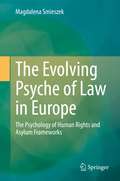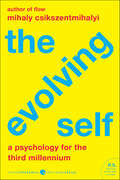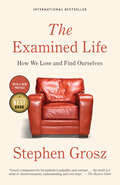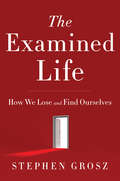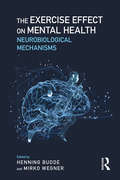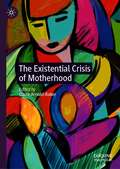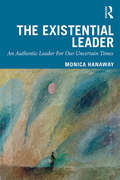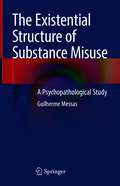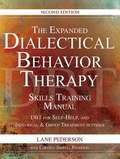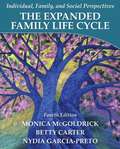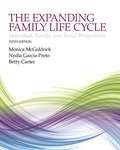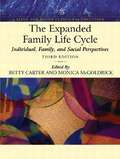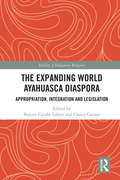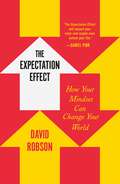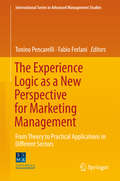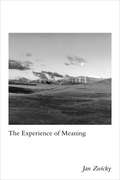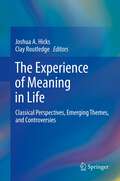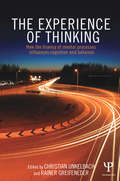- Table View
- List View
The Evolving Psyche of Law in Europe: The Psychology of Human Rights and Asylum Frameworks
by Magdalena SmieszekThe book applies an interdisciplinary analytical framework, based on social psychology theories of inclusion and exclusion, to a discussion of legal discourse and the development of legal frameworks in Europe concerning migrants, asylum seekers, refugees, and European citizens. It adopts a psycho-historical perspective to discuss the evolution of international and European law with regard to the rights of citizens and asylum-seeking non-citizens, from the law’s inception following the Second World War up to present-day laws and policies. The book reveals the embracing of a European identity based on human rights as the common feature in European treaties and institutions, one that is focused on European citizens and has inclusionary objectives. However, a cognitive dissonance can also be found, as this common identity-making runs counter to national proclivities, as well as securitized, threat-perception-oriented perspectives that can produce exclusionary manifestations concerning persons seeking asylum. In particular, a view of inclusion and exclusion via legal categorizations of status, as well as distributions of social and economic rights, draws attention to the links between social psychology and international law. What emerges in the analysis: a process of creating value is present both at its psychological roots and the expressions of value in the law. Fundamentally speaking, the emergence of laws and policies that center on human beings and human dignity, when understood from a psychological and emotion-based perspective, has the potential to transcend the dissonances identified.
The Evolving Self: A Psychology for the Third Millennium (Harper Perennial Modern Classics Ser.)
by Mihaly CsikszentmihalyiThe renowned author of Flow shares a “wise, humane inquiry” into the evolution of consciousness—and how we can rewire our minds for contemporary life (Publishers Weekly).In Mihaly Csikszentmihalyi’s bestselling Flow, he introduced readers to a radical new theory of happiness. Now in The Evolving Self—his breakthrough sequel—he demonstrates how we can understand and overcome our evolutionary shortcomings in order to build a stable, meaningful future for ourselves and each other. The Evolving Self covers the challenges associated with our cognitive evolutionary history; the distortions of reality we experience due to genes, culture, and our sense of self; and the central importance of “flow” from an evolutionary perspective. Erudite, insightful, and practical, The Evolving Self is a timely resource for anyone looking to improve our world for ourselves and for generations to come.“A book of singular importance and timeliness, one with momentous implications for the future.” —Howard Gardner
The Evolving Self: Problem And Process In Human Development
by Robert KeganThe Evolving Self focuses upon the most basic and universal of psychological problems—the individual’s effort to make sense of experience, to make meaning of life. According to Robert Kegan, meaning-making is a lifelong activity that begins in earliest infancy and continues to evolve through a series of stages encompassing childhood, adolescence, and adulthood. The Evolving Self describes this process of evolution in rich and human detail, concentrating especially on the internal experience of growth and transition, its costs and disruptions as well as its triumphs. At the heart of our meaning-making activity, the book suggests, is the drawing and redrawing of the distinction between self and other. Using Piagetian theory in a creative new way to make sense of how we make sense of ourselves, Kegan shows that each meaning-making stage is a new solution to the lifelong tension between the universal human yearning to be connected, attached, and included, on the one hand, and to be distinct, independent, and autonomous on the other. The Evolving Self is the story of our continuing negotiation of this tension. It is a book that is theoretically daring enough to propose a reinterpretation of the Oedipus complex and clinically concerned enough to suggest a variety of fresh new ways to treat those psychological complaints that commonly arise in the course of development. Kegan is an irrepressible storyteller, an impassioned opponent of the health-and-illness approach to psychological distress, and a sturdy builder of psychological theory. His is an original and distinctive new voice in the growing discussion of human development across the life span.
The Evolving Self: Problem and Process in Human Development
by Robert KeganThe Evolving Self focuses upon the most basic and universal of psychological problems--the individual's effort to make sense of experience, to make meaning of life. According to Robert Kegan, meaning-making is a lifelong activity that begins in earliest infancy and continues to evolve through a series of stages encompassing childhood, adolescence, and adulthood. The Evolving Self describes this process of evolution in rich and human detail, concentrating especially on the internal experience of growth and transition, its costs and disruptions as well as its triumphs. At the heart of our meaning-making activity, the book suggests, is the drawing and redrawing of the distinction between self and other. Using Piagetian theory in a creative new way to make sense of how we make sense of ourselves, Kegan shows that each meaning-making stage is a new solution to the lifelong tension between the universal human yearning to be connected, attached, and included, on the one hand, and to be distinct, independent, and autonomous on the other. The Evolving Self is the story of our continuing negotiation of this tension. It is a book that is theoretically daring enough to propose a reinterpretation of the Oedipus complex and clinically concerned enough to suggest a variety of fresh new ways to treat those psychological complaints that commonly arise in the course of development. Kegan is an irrepressible storyteller, an impassioned opponent of the health-and-illness approach to psychological distress, and a sturdy builder of psychological theory. His is an original and distinctive new voice in the growing discussion of human development across the life span.
The Examined Life
by Stephen GroszThe everyday world bedevils us. To make sense of it, we tell ourselves stories. Here, in short, vivid, dramatic tales, psychoanalyst Stephen Grosz draws from his twenty-year practice to track the collaborative journey of therapist and patient as they uncover the hidden feelings behind ordinary behavior. A woman finds herself daydreaming as she returns home from a business trip; a young man loses his wallet. We learn, too, from more extreme examples: the patient who points an unloaded gun at a police officer, the compulsive liar who convinces his wife he's dying of cancer. These beautifully rendered tales illuminate the fundamental pathways of life from birth to death. They invite compassionate understanding, suggesting answers to the questions that compel and disturb us most about love and loss, parents and children, work and change. The resulting journey will spark new ideas about who we are and why we do what we do.
The Examined Life: How We Lose and Find Ourselves
by Stephen GroszAn extraordinary book for anyone eager to understand the hidden motives that shape our lives. We are all storytellers--we create stories to make sense of our lives. But it is not enough to tell tales. There must be someone to listen. In his work as a practicing psychoanalyst, Stephen Grosz has spent the last twenty-five years uncovering the hidden feelings behind our most baffling behavior. The Examined Life distils more than 50,000 hours of conversation into pure psychological insight without the jargon. This extraordinary book is about one ordinary process: talking, listening, and understanding. Its aphoristic and elegant stories teach us a new kind of attentiveness. They also unveil a delicate self-portrait of the analyst at work and show how lessons learned in the consulting room can reveal as much to the analyst as to the patient. These are stories about our everyday lives: they are about the people we love and the lies we tell, the changes we bear and the grief. Ultimately, they show us not only how we lose ourselves but also how we might find ourselves.
The Examined Life: How We Lose and Find Ourselves
by Stephen GroszThe everyday world bedevils us. To make sense of it, we tell ourselves stories. Here, in short, vivid, dramatic tales, psychoanalyst Stephen Grosz draws from his twenty-year practice to track the collaborative journey of therapist and patient as they uncover the hidden feelings behind ordinary behavior. A woman finds herself daydreaming as she returns home from a business trip; a young man loses his wallet. We learn, too, from more extreme examples: the patient who points an unloaded gun at a police officer, the compulsive liar who convinces his wife he's dying of cancer. These beautifully rendered tales illuminate the fundamental pathways of life from birth to death. They invite compassionate understanding, suggesting answers to the questions that compel and disturb us most about love and loss, parents and children, work and change. The resulting journey will spark new ideas about who we are and why we do what we do.
The Executive Functioning Workbook for Teens: help for unprepared, late & scattered teens
by Sharon A. HansenThe book also includes tips for initiating positive action and change, improving flexibility in thinking, sustaining attention, organizing, planning, enhancing memory, managing emotions, and building self-awareness.
The Exercise Effect on Mental Health: Neurobiological Mechanisms
by Henning Budde Mirko WegnerThe Exercise Effect on Mental Health contains the most recent and thorough overview of the links between exercise and mental health, and the underlying mechanisms of the brain. The text will enhance interested clinicians’ and researchers’ understanding of the neurobiological effect of exercise on mental health. Editors Budde and Wegner have compiled a comprehensive review of the ways in which physical activity impacts the neurobiological mechanisms of the most common psychological and psychiatric disorders, including depression, anxiety, bipolar disorder, and schizophrenia. This text presents a rigorously evidence-based case for exercise as an inexpensive, time-saving, and highly effective treatment for those suffering from mental illness and distress.
The Existential Crisis of Motherhood
by Claire Arnold-BakerThis book offers a new perspective on the motherhood experience. Drawing on existential philosophy and recent phenomenological research into motherhood, the book demonstrates how motherhood can be understood as an existential crisis. It argues that an awareness of the existential issues women face will enable mothers to gain a deeper understanding of the multifaceted aspects of their experience. The book is divided into four sections: Existential Crisis, Maternal Mental Health Crisis, Social Crisis and Working with Existential Crisis, where each section. Each chapter is based on either experiential research or the author’s extensive therapeutic experience of working with mothers and reflects different aspects of the motherhood journey, all through the lens of a philosophical existential approach. The book is essential reading for mental health practitioners and researchers working with mothers, midwives and health visitors, but it is also written for mothers, with the aim to offer new insights on this important life transition.
The Existential Importance of the Penis: A Guide to Understanding Male Sexuality
by Daniel N. WatterThe first of its kind, this book applies existential principles to sexual problems, providing clinicians with the tools to understand male sexuality more deeply. Alighting from the existential psychotherapy tenets of Irvin D. Yalom, Watter introduces the notion that the penis is a conduit for male emotion, and hence regulates their ability to form and experience intimate relationships. Subsequent chapters explore an existential view of male sexual dysfunction, non-sexual trauma, hypersexuality, changing bodies through illness, age, and injury, and examines badly behaved men to understand the meaning of certain behaviors. This book will be an invaluable resource for sex therapists, marriage and family therapists, psychologists, and social workers in practice and in training, assisting them to develop the therapeutic skills that will improve their understanding of men’s psychological experience.
The Existential Leader: An Authentic Leader For Our Uncertain Times
by Monica HanawayThe Existential Leader: An Authentic Leader For Our Uncertain Times invites us to reconsider our preconceptions about leadership, introducing a new model more in line with our uncertain times: existential leadership. Monica Hanaway presents an illuminating overview of existential thinking and describes how an understanding of philosophy can improve leadership, drawing on existing leadership theories to show how this new model is more fitting for the challenges of today. The approach is primarily philosophical, rather than systemic or behavioural. It invites us to re-examine what we think about leaders, whether we really need leaders at all, and, if so, which existential concerns leaders must address. The book offers an introduction to the development of existential thinking and main concerns, including meaningfulness, anxiety, loneliness, freedom, choice and responsibility, authenticity, and values and beliefs. These are explored in the leadership context, with practical approaches for using these in everyday leadership dilemmas. Unique and accessible, The Existential Leader paves a way for modern leadership perfectly suited to the challenging times we live in. Innovative, theoretical and applicable to our changing world landscape, this book will appeal to coaches, HR and L&D professionals, executives, business consultants, and current and future leaders. It will also be of interest to academics and students of coaching psychology, applied philosophy and psychology.
The Existential Structure of Substance Misuse: A Psychopathological Study
by Guilherme MessasThis book contributes to one of the most challenging areas of mental health: substance misuse. Its focus is on the psychopathological experiences associated with it: both the consequences of substance misuse and the existential vulnerabilities that lead to it, even if such a clear-cut distinction is rarely possible. The work brings an innovative perspective to the issue, as it draws on two scientific fields whose association has not yet been fully explored: phenomenological psychopathology and substance misuse studies. The association of these two perspectives could build a greater understanding of this important topic and be of practical help to a wide array of professionals in their clinical practice. The structure of the book is inspired by this overall perspective. Its division into three parts is designed to introduce the reader, in a stepwise manner, to the complexities of the theme, based on the latest advances in the specific literature. The broad objective of this work is therefore to offer a useful instrument for mental health clinicians, psychiatrists, psychologists, nurses, undergraduate students of these disciplines, and all substance abuse workers.
The Expanded Dialectical Behavior Therapy Skills Training Manual: DBT for Self-Help and Individual & Group Treatment Settings (Second Edition)
by Lane Pederson Cortney Sidwell PedersonThis second edition is the most comprehensive and readable DBT manual available with more skills than any other DBT book on the market. <p><p> Beyond updates to the classic skills modules, clients and therapists will be enriched by added modules that include Dialectics, Cognitive Modification, Problem-Solving, and Building Routines as well as all-new, much-needed modules on Addictions and Social Media. <p> Designed for DBT therapists, eclectic and integrative therapists, and as a self-help guide for people interested in learning DBT skills, the straightforward explanations and useful worksheets contained within make DBT skills learning and practice accessible and practical for both skills groups and individual users.
The Expanded Family Life Cycle: Individual, Family, and Social Perspectives (4th edition)
by Betty Carter Monica Mcgoldrick Nydia Garcia PretoThis classic family therapy text reflects changes in society away from orientation toward the nuclear family, toward a more diverse and inclusive definition of "family" and integrates theory and current research with clinical guidelines and cases.
The Expanded Family Life Cycle: Individual, Family, and Social Perspectives (Fifth Edition)
by Nydia A. Garcia Preto Monica McGoldrick Betty A. CarterUpdated, expanded, and more comprehensive than ever, this new Fifth Edition a classic family therapy resource, The Expanded Family Life Cycle, gives readers a solid understanding of human development and the life cycle. Featured are a groundbreaking integration of individual development within a systemic context discussion of the increasing racial, ethnic, and cultural diversity across the life cycle in the United States today; life cycle perspectives on LGBT issues, alcohol, sexuality, migration, social class, violence in the family, and assessment of “home place” as fundamental to clinical work.
The Expanded Family Life Cycle: Individual, Family, and Social Perspectives, 3rd Edition
by Betty Carter Monica McgoldrickHow does one define the concept of "family"? Is it primarily a biological link, or purely a social construction? Can it be a combination of both? Does it have to be? In this age of single parents, alternative lifestyles, and joint custody, "family" has become a fluid term which reflects a sweeping change in society -- from the rigid structure of the nuclear family to a more diverse and inclusive circle of people that one refers to as family. The authors propose a new and more comprehensive way to think about human development and the life cycle,by widening the perspective of family therapy to include diversity of family forms and lifestyles, as well as cultural diversity. Their expanded view of family includes the impact and issues at multiple levels of the human system: the individual, family households, the extended family, the community, the cultural group, and the larger society. Some issues with expanded focus include race, class, sexual orientation, gender, ethnicity, spirituality, politics, work, time, community, values, and belief systems.
The Expanding World Ayahuasca Diaspora: Appropriation, Integration and Legislation (Vitality of Indigenous Religions)
by Beatriz Caiuby Labate Clancy CavnarDuring its expansion from the Amazon jungle to Western societies, ayahuasca use has encountered different legal and cultural responses. Following on from the earlier edited collection, The Expanding World Ayahuasca Diaspora continues to explore how certain alternative global religious groups, shamanic tourism industries and recreational drug milieus grounded in the consumption of the traditionally Amazonian psychoactive drink ayahuasca embody various challenges associated with modern societies. Each contributor explores the symbolic effects of a "bureaucratization of enchantment" in religious practice, and the "sanitizing" of indigenous rituals for tourist markets. Chapters include ethnographic investigations of ritual practice, transnational religious ideology, the politics of healing and the invention of tradition. Larger questions on the commodification of ayahuasca and the categories of sacred and profane are also addressed. Exploring classic and contemporary issues in social science and the humanities, this book provides rich material on the bourgeoning expansion of ayahuasca use around the globe. As such, it will appeal to students and academics in religious studies, anthropology, sociology, psychology, cultural studies, biology, ecology, law and conservation.
The Expectation Effect: How Your Mindset Can Change Your World
by David Robson“As David Robson makes plain in this compelling book, the way we think about the world can profoundly shape how we navigate it. Based in science and packed with smart advice, The Expectation Effect will expand your mind—and maybe even extend your life.”—Daniel Pink, New York Times bestselling author of When, Drive, and To Sell Is HumanA journey through the cutting-edge science of how our mindset shapes every facet of our lives, revealing how your brain holds the keys to unlocking a better youWhat you believe can make it so.You’ve heard of the placebo effect and how sugar pills can accelerate healing. But did you know that sham heart surgeries often work just as well as placing real stents? Or that people who think they’re particularly prone to cardiovascular disease are four times as likely to die from cardiac arrest? Such is the power and deadly importance of the expectation effect—how what we think will happen changes what does happen.Melding neuroscience with narrative, science journalist David Robson takes readers on a deep dive into the many life zones the expectation effect permeates. We see how people who believe stress is beneficial become more creative when placed under strain. We see how associating aging with wisdom can add seven plus years to your life. People say seeing is believing but, over and over, Robson proves that the converse is truer: believing is seeing.The Expectation Effect is not woo-woo. You cannot think your way into a pile of money or out of a cancer diagnosis. But just because magical thinking is nonsense doesn’t mean rational magic doesn’t exist. Pointing to accepted psychology and objective physiology, Robson gives us the practical takeaways we need to improve our fitness, productivity, intelligence, and happiness. Any reader who wants to take their fate into their own hands need only pick up this book.
The Experience Logic as a New Perspective for Marketing Management: From Theory To Practical Applications In Different Sectors (International Series in Advanced Management Studies)
by Tonino Pencarelli Fabio ForlaniThis book provides stimulating insights into the ways in which the adoption of experience logic can revitalize marketing perspectives and stimulate novel approaches to the creation and delivery of value. The first part of the book, which has a theoretical focus, reviews the international literature and offers conceptual observations on the experiential perspective. Suggestions are made on how experience logic can act as a new driver for the management of marketing processes in firms within the context of the experience economy. In the second part of the book, attention turns to the applications of experience logic in different sectors, including tourism, commerce, culture, and trade shows. Company-specific examples of benefits of the experiential approach are also explored in case studies on gift box providers, marketing of traditional local products, and the cosmetics industry. The book will be of particular interest for marketing specialists, but will additionally be of value for managers in private companies and public bodies who wish to enhance their marketing methods.
The Experience Machine: How Our Minds Predict and Shape Reality
by Andy ClarkA brilliant new theory of the mind that upends our understanding of how the brain interacts with the world&“This thoroughly readable book will convince you that the brain and the world are partners in constructing our understanding.&” —Sean Carroll, New York Times bestselling author of The Biggest Ideas in the Universe: Space, Time, and MotionFor as long as we&’ve studied human cognition, we&’ve believed that our senses give us direct access to the world. What we see is what&’s really there—or so the thinking goes. But new discoveries in neuroscience and psychology have turned this assumption on its head. What if rather than perceiving reality passively, your mind actively predicts it?Widely acclaimed philosopher and cognitive scientist Andy Clark unpacks this provocative new theory that the brain is a powerful, dynamic prediction engine, mediating our experience of both body and world. From the most mundane experiences to the most sublime, reality as we know it is the complex synthesis of sensory information and expectation. Exploring its fascinating mechanics and remarkable implications for our lives, mental health, and society, Clark nimbly illustrates how the predictive brain sculpts all human experience. Chronic pain and mental illness are shown to involve subtle malfunctions of our unconscious predictions, pointing the way towards more effective, targeted treatments. Under renewed scrutiny, the very boundary between ourselves and the outside world dissolves, showing that we are as entangled with our environments as we are with our onboard memories, thoughts, and feelings. And perception itself is revealed to be something of a controlled hallucination.Unveiling the extraordinary explanatory power of the predictive brain, The Experience Machine is a mesmerizing window onto one of the most significant developments in our understanding of the mind.
The Experience and Meaning of Work in Women's Lives
by Hildreth Y. Grossman Nia Lane ChesterIn the past, social scientists have relied predominantly on traditional models of work to understand women's experiences. These models, however, have been based on men's occupational experiences, which have been assumed to be the same for women. More recently, researchers and theorists from a variety of disciplines have begun to challenge earlier assumptions as inaccurate reflections of the realities for female workers. Newer studies have concentrated on the historical and social reasons for women's employment and career choices, including changes in economy, family, and social conditions. To provide a deeper understanding of women worker's realities by including the meaning they make of their work experiences, the editors have assembled the research of social scientists from various disciplines whose investigations focused exclusively on this subject. Their qualitative methodology provides a forum for women to voice issues, raise questions, and share self-reflections about their work experiences and the meaning they make of their work in the context of the rest of their lives. The common themes that are interwoven within the fabric of women's work experience are: the need to expand traditional definitions of what constitutes "work;" the fluid nature of boundaries between personal life and work life; the importance of the relational aspects of their work; the issues related to the uses of power at work; the role of work in the development of women's sense of self and personal identity; and the degree to which women's work experience is colored by discrimination and sexism.
The Experience of Meaning
by Jan ZwickyThe aim of this book is a recovery of interest in the experience of meaning. Jan Zwicky defends the claim that we experience meaning in the apprehension of wholes and their internal structural relations, providing examples of such insight in mathematics and physics, literature, music, and Plato's ancient theory of forms. Taken together, these essays constitute a powerful indictment of the aggressive reductionism and the reliance on calculative modes of thought that dominate our present conception of understanding. The Experience of Meaning proposes a more just epistemology, arguing for a new grammar of thought, a new way of understanding the relationship of human intelligence to the world. Engaging with philosophy, psychology, literature, fine arts, music, and environmental studies in a profound way, The Experience of Meaning will interest any reader who ponders the question of meaning and its relation to true human expression.
The Experience of Meaning in Life: Classical Perspectives, Emerging Themes, and Controversies
by Joshua A. Hicks Clay RoutledgeThis book offers an in-depth exploration of the burgeoning field of meaning in life in the psychological sciences, covering conceptual and methodological issues, core psychological mechanisms, environmental, cognitive and personality variables and more.
The Experience of Thinking: How the Fluency of Mental Processes Influences Cognition and Behaviour
by Rainer Greifeneder Christian UnkelbachWhen retrieving a quote from memory, evaluating a testimony’s truthfulness, or deciding which products to buy, people experience immediate feelings of ease or difficulty, of fluency or disfluency. Such "experiences of thinking" occur with every cognitive process, including perceiving, processing, storing, and retrieving information, and they have been the defining element of a vibrant field of scientific inquiry during the last four decades. This book brings together the latest research on how such experiences of thinking influence cognition and behavior. The chapters present recent theoretical developments and describe the effects of these influences, as well as the practical implications of this research. The book includes contributions from the leading scholars in the field and provides a comprehensive survey of this expanding area. This integrative overview will be invaluable to researchers, teachers, students, and professionals in the field of social and cognitive psychology.
